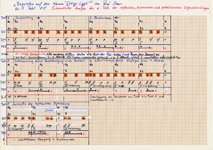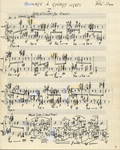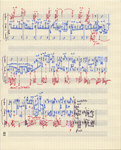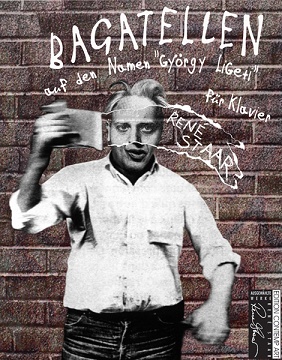»Dedicated to György Ligeti in deep admiration«
For piano
Duration: ca. 21 minutes
Austrian Premiere of the complete cycle: March 3, 1999, Arnold Schönberg Center (Vienna) by Johannes Marian
German Premiere of the complete cycle: December 9, 2022, Mannheim (Florian-Waldeck-Saal, Museum Zeughaus), by Johannes Piirto
Published by Edition Contemp Art (Verlagsgruppe Hermann),
Obtainable via www.schott-music.com
Product number: VGH DVGH 99-70 Q569683 (e-sheet music, PDF)
Nr. 1 Fast
Premiere: 1991, Tokyo, René Staar
Duration: 1'50''
Score (Extract, Pdf)
Nr. 2 Calmly flowing in the form of a passacaglia
Premiere: 1994, Odessa, Johannes Marian
Duration: 2'20''
Nr. 3 Allegretto in reflections
Premiere: 1996, Milan, Johannes Marian
Duration: 1'00''
Nr. 4 Presto possibile
Premiere: 1996, Milan, Johannes Marian
Duration: 1'30''
Nr. 5 Rhapsodisch, mit großem Schwung
Duration: 3'00''
Nr. 6 Frozen in clattering granite
»For Johannes Marian«
Premiere: September 28, 1998, Karajan Center (Vienna), Johannes Marian
Duration: 5'10''
Nr. 7 Swaying Durations (Largo)
Duration: 2'45''
Nr. 8 Broken Spectra
Uraufführung: November 27, 1998, Lisbon, Johannes Marian
Duration: 3'15''
|
René Staar - Zerbrochene Spektren |
|
Johannes Marian, piano
Preface to the Bagatelles (Sigrid Wiesmann)
René Staar’s compositional work can be divided into three periods. The first, characterized by the incorporation of elements of improvisation, was followed by a phase concerned with the evolution of melodic and motivic structures, a phase stimulated by personal experiences and personal contacts, such as those with Hans Swarowsky and Leonard Bernstein. The chamber music works Jeux, Op. 1 for violin and viola (1976), the Fantasy for four Violas Op. 6 (1979/80), and the string quartet Structures III Op. 7/3 (1981) demonstrate Staar’s search for connections to the sound world of modernity and for an individual form of expression. In the next period the diverging compositional structures have in common the vertical (harmonic) formations and the search for an inclusive system of harmony. The composition Just an Accident? A Requiem for Anton Webern and other Victims of the Absurd Op. 9 (1985), on a text by Alan Levy, for which the composer received in 1986 the newly inaugurated Ernst Krenek Prize of the City of Vienna, also belongs to this phase. During the composition of … ich bin es, ohne dass es mir gleicht … (… I am that, but that is not what I am … ) Op. 19, for soprano, baritone, and chamber ensemble, written in 1987 on a text by Michael Cerha, Staar developed his chord realignment theory, which has since then formed the basis for his works and led to new sound experiences. Radicalization of the tonal language through strict observance of the newly created rules and condensation to a minimum led to intense and poignant works such as the six sketches for string quartet Versunkene Träume (Vanished Dreams) Op. 22c, written in 1993.
In the Bagatelles on the name of György Ligeti Op. 14/3 for piano (two hands), composed in 1989-90 and in 1995-96, this chord realignment theory is further refined. The musical letters G—G—G—E found in the name György Ligeti constitute a perfect starting point for the composition. The minor third interval G—E is hidden in a variety of chords and provides an invisible and inaudible connection to the name Ligeti. This minor third is incorporated in all the basic chords fundamental to these Bagatelles.
In the first Bagatelle the harmony is arrived at through rearrangement of the intervals in the chords, yielding an autonomous melodic-harmonic succession. The disposition of the second Bagatelle (in the form of a passacaglia) incorporates four tones of a fundamental chord within each 10/8 measure. Six cycles and their mirrored reversals determine the course of the third Bagatelle, while condensation and dissolution determine the form of the fourth. The components of the fifth Bagatelle manifest themselves in a seemingly arbitrary manner.
After a five-year pause, Staar resumed work on the Bagatelles in 1995. The sixth Bagatelle places enormous demands on the interpreter, who must master rhythmical divisions within complex tempo relations and also develop a feeling for highly differentiated articulations. In the seventh Bagatelle the six-voice chord is divided through rhythmic scattering into its component tones, while the eighth and last Bagatelle—which Staar calls Broken Spectra—expands the rhythms based on tempo relations that were developed in the sixth Bagatelle in the most complex manner conceivable. A detailed analysis by the composer, explanatory texts and the multi-colored structural charts make this edition the up to now most significant presentation regarding the oeuvre of René Staar. Through these Bagatelles, the composer intends to create a model for the practical realization of his discoveries in music theory and compositional technique.
The Bagatelles are not only one of Staar’s most significant works; they are also among the most difficult works of the piano literature and provide an immense stimulation and challenge for composers and pianists. The eight Bagatelles have a total duration of 21 minutes, but they can also be performed separately or in smaller combinations. In this last case the composer suggests the following sequences: Play Bagatelles I—IV; or VI—VIII; or I—VII—VIII—IV; or I—II—IV—V—VI. The interpreter is however free to choose other combinations. {Sigrid Wiesmann, Translation: Jorge E. López}
 Manuskriptseite Bagatelle - Analyse Originalgrösse |
 Manuskriptseite Bagatelle - Analyse Originalgrösse |
 Manuskriptseite Bagatelle - Analyse Originalgrösse |



